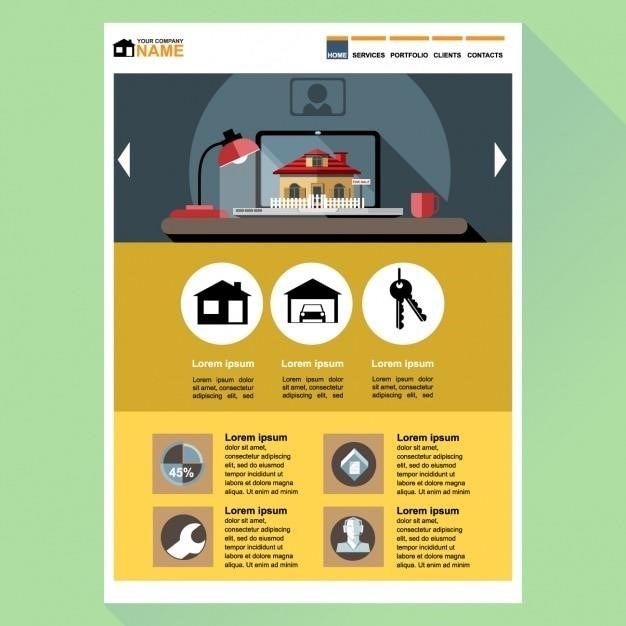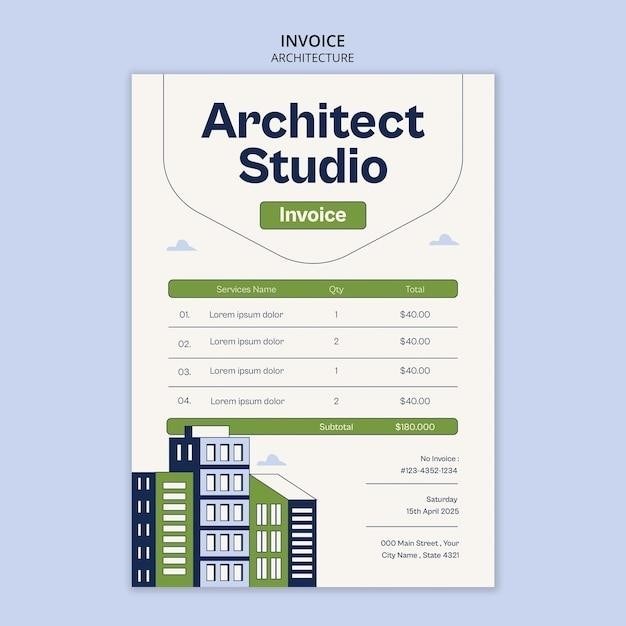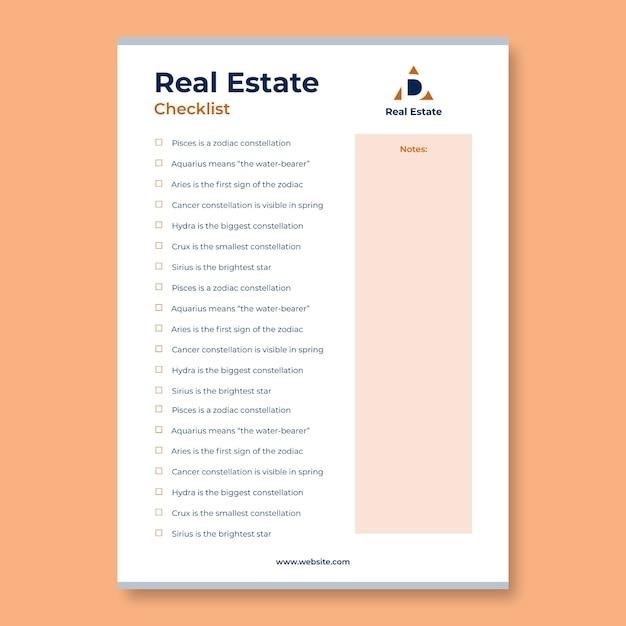ultimate home building checklist pdf

ultimate home building checklist pdf
Ultimate Home Building Checklist PDF⁚ A Comprehensive Guide
Download your free comprehensive guide to building a home. This checklist covers every stage, from initial planning and land acquisition through construction phases, final inspections, and post-construction tasks. Avoid costly mistakes with our detailed steps and helpful tips for a smooth building process. Access your PDF now and begin building your dream home!
I. Planning & Pre-Construction Phase
The initial planning phase is crucial for a successful home building project. Begin by defining your needs and budget. Consider the size, style, and features of your dream home. Thorough research is key. Investigate different building materials, contractors, and potential cost savings. Next, secure financing. Explore mortgage options and secure pre-approval to understand your financial capacity. Simultaneously, start searching for a suitable plot of land. Research zoning regulations, building restrictions, and covenants specific to your chosen location. Conduct a thorough title search to ensure clear ownership and absence of any encumbrances. A land survey is essential to establish accurate property boundaries and identify any potential issues. Soil testing will determine the suitability of the land for construction, informing foundation design and material selection. This comprehensive approach will ensure a solid foundation for your project, minimizing potential delays and cost overruns.
II. Land Acquisition & Due Diligence
Once you’ve identified a potential building site, thorough due diligence is paramount. Begin with a comprehensive title search to verify ownership and uncover any liens, easements, or other encumbrances that could impact your project. Engage a surveyor to establish precise property boundaries and identify any potential topographical challenges, such as slopes or drainage issues. Review zoning regulations and building codes applicable to the site. Ensure your planned construction complies with all local ordinances to avoid delays and potential legal issues. Assess the soil conditions through appropriate testing. Understanding soil composition is vital for proper foundation design and construction. Investigate utility access, including water, sewer, electricity, and gas lines. Confirm their availability and location to plan for efficient connections during construction. Finally, negotiate the purchase price and terms with the seller, engaging a real estate attorney to review the contract and protect your interests. This meticulous approach will safeguard your investment and minimize potential future complications.
III. Design & Permits
Transforming your vision into a tangible plan requires a collaborative effort with architects and designers. Detailed blueprints are essential, outlining the structural components, spatial arrangements, and aesthetic features of your home. These plans must adhere to building codes and zoning regulations, ensuring structural integrity and safety. Simultaneously, navigate the permitting process by submitting your comprehensive plans to the relevant authorities. This may involve several applications, including a building permit, which grants you legal permission to commence construction. Expect thorough review of your plans; revisions may be requested to ensure compliance with local standards. Obtain all necessary approvals before breaking ground. Engage a structural engineer to verify the structural soundness of the design, ensuring stability and safety against various environmental factors. Secure all required permits well in advance of the construction start date to avoid potential delays. This proactive approach streamlines the process, allowing for a smooth transition into the construction phase.
IV. Construction Phases⁚ Foundation
The foundation, the unsung hero of your home, demands meticulous attention. Begin with site preparation, ensuring the land is level and properly compacted. Excavation follows, creating the space for the foundation. The type of foundation—be it a slab, crawlspace, or basement—dictates the next steps. For a poured concrete foundation, install formwork, reinforcing steel, and pour the concrete, ensuring proper curing time. For a crawlspace or basement, construct the walls using concrete blocks or poured concrete, paying close attention to waterproofing and drainage. Regular inspections are vital throughout this stage. Verify the foundation’s alignment, ensuring it’s level and plumb. Check for cracks or settling, addressing any issues promptly. Proper compaction of the soil beneath the foundation is crucial to prevent future settling. Thorough inspection by a qualified professional ensures the foundation meets the required specifications for stability and load-bearing capacity. A solid foundation is paramount for the structural integrity and longevity of your entire home.
V. Construction Phases⁚ Framing & Roofing
Framing, the skeletal structure of your home, begins with the floor joists, followed by wall framing. Ensure proper spacing and alignment of studs, using appropriate fasteners. Install headers over windows and doors, providing structural support. Sheathing, typically plywood or OSB, covers the framed walls, providing a solid base for exterior cladding. Roof framing follows, constructing the trusses or rafters according to the design plans. Proper bracing is essential to ensure stability and withstand wind loads. Install roofing felt or underlayment before laying the roofing material. Choose your roofing material carefully, considering factors like cost, durability, and aesthetic appeal. Regular inspections during framing are critical. Verify that all framing members are properly sized and spaced, ensuring structural integrity. Check for squareness and plumbness of walls. Inspect the roof structure for proper slope and alignment, ensuring water runoff. Ensure all connections are secure and properly fastened. Addressing any issues promptly will prevent costly problems later. A properly framed and roofed structure is essential for the long-term safety and stability of your home.
VI. Construction Phases⁚ MEP (Mechanical, Electrical, Plumbing)

This crucial phase involves the installation of your home’s essential systems. Plumbing begins with rough-in, installing pipes for water supply and drainage. Ensure proper sizing and slope for efficient drainage. Pressure testing is vital to detect leaks before walls are closed. Electrical rough-in follows, running wiring for outlets, lighting, and appliances. All wiring must adhere to local electrical codes for safety. Proper grounding and circuit protection are paramount. Inspect all wiring connections meticulously. HVAC (Heating, Ventilation, and Air Conditioning) installation usually occurs concurrently. Ductwork is installed, ensuring proper airflow throughout the house. The unit itself is positioned and connected. Regular inspections are necessary to ensure efficient operation. MEP systems are complex and require skilled professionals. Prior to drywall installation, a thorough inspection of all MEP systems is recommended. Verify that all pipes and wires are correctly routed and secured. Confirm proper insulation of pipes and ducts to minimize energy loss. Thorough testing of all systems—including water pressure testing, electrical load testing, and HVAC performance testing—is vital before moving to the next phase. Addressing any discrepancies early prevents costly rework later.
VII. Construction Phases⁚ Interior Finishes
This stage transforms the structure into a comfortable and aesthetically pleasing home. Drywall installation is the first step, ensuring smooth walls and ceilings. Careful taping and mudding are essential for a flawless finish. Once dry, sanding and priming prepare the surfaces for painting. Choose high-quality paint for durability and aesthetic appeal. Flooring installation follows, selecting from various options like hardwood, tile, or carpet. Ensure proper underlayment for comfort and longevity. Cabinet installation brings functionality and style to the kitchen and bathrooms. Accurate measurements and level installation are crucial. Countertop installation complements the cabinets, offering durability and style. Consider material choices carefully, balancing aesthetics and practicality. Interior doors and trim add finishing touches, enhancing the overall look and feel of the space. Proper installation ensures smooth operation and a clean appearance. Lighting fixtures are installed, completing the electrical work. Choose fixtures that complement the style and functionality of each room. Final paint touch-ups and cleaning ensure a pristine finish. A walk-through with the builder allows for final inspection and addressing any minor issues. This meticulous attention to detail ensures a beautiful and functional home ready for occupancy. Remember to keep detailed records of material choices and installation processes.
VIII. Final Inspections & Handover
The final stages involve meticulous inspections to ensure the home meets all building codes and agreed-upon specifications. Schedule a thorough walk-through with the builder, meticulously checking every detail of the interior and exterior. Verify that all fixtures and appliances are functioning correctly and that there are no outstanding repairs or defects. Pay close attention to the quality of workmanship, ensuring everything is installed to the highest standards. Document any discrepancies or issues immediately, taking photos or videos as evidence. The building inspector’s final sign-off is crucial, confirming compliance with all regulations. This ensures the safety and structural integrity of your new home. Obtain copies of all inspection reports and certifications for your records. Once all inspections are completed and any necessary repairs addressed, the formal handover process begins. This involves the transfer of ownership and possession of the property. Review all the necessary paperwork, including the final payment schedule and warranty information. Carefully read through all contracts and documents before signing to ensure you fully understand the terms and conditions. The builder should provide a comprehensive overview of the home’s systems and maintenance procedures. This ensures you’re equipped to care for your new property effectively. Remember to keep all relevant documentation in a safe and accessible place for future reference.

IX. Post-Construction & Landscaping
After the final inspection and handover, the post-construction phase begins, focusing on final clean-up and landscaping. Ensure all construction debris and leftover materials are removed from the property. A thorough cleaning of the interior and exterior is essential, removing dust and dirt accumulated during construction. Consider professional cleaning services for a deep clean, ensuring a spotless move-in ready environment. Landscaping adds the finishing touch, transforming the property’s exterior. Develop a landscaping plan that complements your home’s architecture and your personal preferences. Choose plants and hardscaping elements that thrive in your local climate and require minimal maintenance. If you’re hiring a landscaping company, obtain multiple quotes and compare services before making a decision. Ensure the contract clearly outlines all aspects of the landscaping project, including timelines and payment schedules. Consider adding walkways, patios, or decks to enhance the outdoor living space. Install lighting to highlight key features and improve safety and security. Remember to factor in the cost of ongoing maintenance, such as regular lawn care and plant trimming. A well-maintained landscape enhances curb appeal and property value, making it a worthwhile investment.
X. Budgeting & Financial Management
Effective financial management is crucial for successful home building. Begin with a realistic budget, considering all costs, including land acquisition, permits, materials, labor, and contingency funds for unforeseen expenses. Explore various financing options, such as mortgages, construction loans, and personal savings. Secure pre-approval for a mortgage to understand your borrowing capacity and interest rates. Regularly track expenses throughout the construction process, comparing actual costs against the budget. Utilize budgeting spreadsheets or software to maintain accurate records. Communicate openly with contractors and subcontractors about payment schedules and milestones to avoid disputes. Obtain multiple quotes for major expenses like foundation work, framing, and MEP (Mechanical, Electrical, Plumbing) systems to ensure competitive pricing. Negotiate contracts carefully, specifying payment terms and deliverables. Establish a contingency fund to cover unexpected costs or delays. Regularly review your financial statements to identify potential issues and adjust your budget accordingly. Consider using project management software to track progress, expenses, and deadlines. Seek professional financial advice if needed, ensuring you make informed decisions throughout the building process. Proper financial planning minimizes stress and ensures your dream home is built within your means;